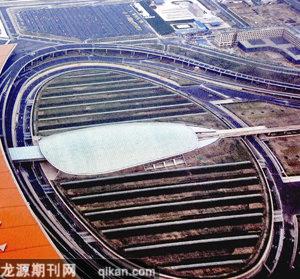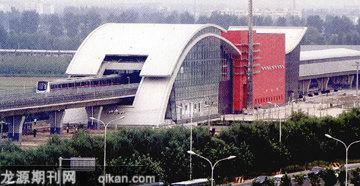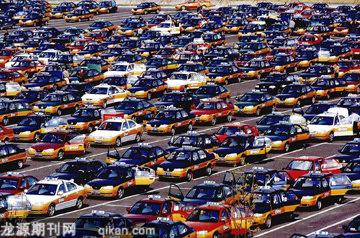Getting Around the Capital
By staff reporter ETHEL LU

THE number of motor vehicles in Beijing hit 3.2 million in February this year – almost double the figure of late 2001. Despite the municipal government having spent some RMB 110 billion on improving traffic systems since Beijing was announced as the host city for the 2008 Olympics, an average day still sees chronic congestion in the capital. In August, hundreds of thousands of athletes, coaches, sports officials, media personnel and tourists will flood into Beijing, placing even more pressure on the city and potentially creating a major headache for residents as well as the government.
Below is a guide to finding your way around Beijings transport options and dodging the traffic.
The Airports New Terminal 3
Beijing Capital International Airport (BCIA) is the first stop for many foreigners coming to China. The long-established terminals 1 and 2 can handle 35 million passengers a year, but this clearly was not going to be enough to handle the Olympic influx. So a decision was made to build a large, ultramodern third terminal.
After three years and nine months of construction and preparation, the new Terminal 3 was unveiled at the end of February. It can accommodate 45 to 50 million people a year. BCIAs 137 aircraft taxi-lanes and 314 aircraft parking bays make it one of the largest airports in the world.
The huge new terminal is also home to 64 food chain stores, including Haagen-Dazs, Rogers, Starbucks, KFC, McDonalds, Pizza Hut and UBC Coffee. When combined with the 43 restaurants in Terminals 1 and 2, travelers are spoiled for choice when it comes to eating.

There are four expressways servicing the airport, including the Airport Expressway to downtown Beijing. Passengers can also take the new Airport Subway Line to Dongzhimen on the western edge of the citys embassy district, home to much of Beijings foreign community.
Improvements to Public Transport
The IC Card was launched in Beijing on the first day of 2007, an important measure to ease traffic pressure. Passengers holding cards receive a 60 percent discount on bus fares, which means many rides cost as little as four jiao (10 jiao make one yuan). Student cardholders enjoy up to 80 percent discounts. The government subsidizes this scheme to the tune of several billion RMB.
The IC Card has been very popular among public transport users, with more than 16 million cards sold since the scheme was introduced. Around a million cards are used on Beijing buses every day. The cards can also be used on the subway, though there they do not provide any discount.
In 2007, 34.5 percent of residents nominated buses as their first choice of transport, says Ji Lin, vice mayor of Beijing. The figure has since increased to more than 40 percent.
The introduction of “bus only” lanes has also improved Beijings public transport. Statistics show that the average speed of buses has increased by six to seven kilometers an hour since more of these lanes were introduced on arterial roads.
The government has arranged 34 special bus lines to Olympic venues, and prolonged the operating hours of some lines to 24 hours a day during the Games. Staff, volunteers, spectators and others identifying themselves as Games-related personnel can take public transport for free, including the subway and light rail.

Extending the
Beijing Subway
Beijing began to build its first subway in 1965, but the first line was not fully open to the public until 1981. By 2001, there were 42 kilometers of lines, but this was not nearly enough to keep up with the capitals explosive growth heading into the 21st century.
At the end of 2002, the Beijing municipal government and BOCOG jointly announced that eight more subway lines would be built. Recent years have seen Line 5, the first phase of Line 10, the Airport Line, and the Batong Line added to the existing Lines 1, 2 and 13. With a total mileage of 200 kilometers, the subway can now transport over 3 million people a day.
The extensions will move into phase two after the Games. Mileage will be doubled when this phase is finished in 2012, and by 2015 phase three will bring another 160 kilometers into service.
Beijing Taxis
Beijings taxi drivers have been trying hard to learn English in preparation for the Olympics. The capital has around 67,000 registered taxis and about 100,000 drivers.
Most taxis are now equipped with GPS, making it much easier for taxi companies to dispatch cabs for customers using booking services. In some cabs, people can also find a translation service accessible via phone, as featured in the May issue of China Today.
There are two taxi service numbers in Beijing: 68373399 for the Beijing Taxi Dispatching Center, and 96103 for Yinjian Taxi Company. Customers are charged a booking fee of RMB 3 for using these services.
The flag-fall for Beijing taxis is RMB 10, which covers the first three kilometers of the trip. The meter will then charge RMB 2 for every additional kilometer. Between 11 p.m. and 5 a.m. the flag-fall rises to RMB 11.
Electronic Subway Tickets
Single-ride tickets for the Beijing subway cost RMB 2, and allow users to go anywhere on the system, including interchanges between lines (Airport Line not included).
Tickets can now be purchased using coins from automatic vending machines in subway stations. Change can be obtained from service windows at the entrances to station platforms. In June, an Automatic Fare Collection (AFC) system was introduced, which means users need to insert their tickets into electronic turnstiles when entering a station. Single-ride tickets are then collected automatically by electronic turnstiles at the users destination.
After inserting their ticket into the automatic turnstiles, passengers should go through within 10 seconds. If the turnstile closes before passengers pass through, they can ask staff for assistance.
Bus/Subway IC Cards
Rechargeable transport cards, useable on Beijing buses and the subway, can be obtained by paying a RMB 20 deposit. For tourists, short-term cards are available. A three-day card can be purchased for RMB 10, a seven-day card for RMB 20, or a 15-day card for RMB 40. These give users 18, 42 or 90 rides, respectively.
IC cards can also be used on Beijings subway, where users are charged RMB 2 to go anywhere on the system. Cardholders need to swipe their card when entering a station, and again at their destination.
IC cards are available from bus terminals, post offices or subway stations, and can be recharged at bus terminals and machines at the entrances to subway platforms.

